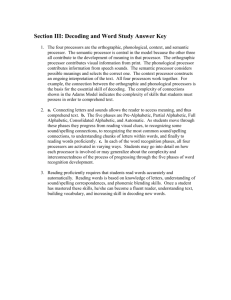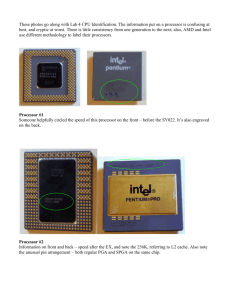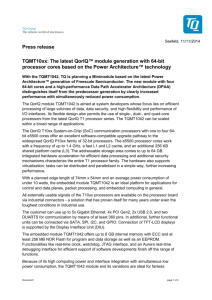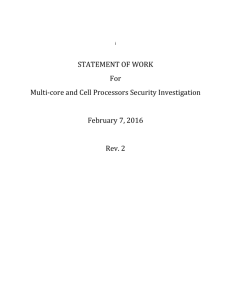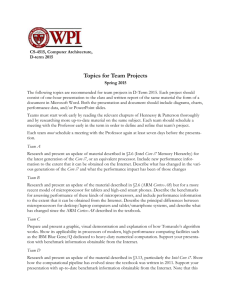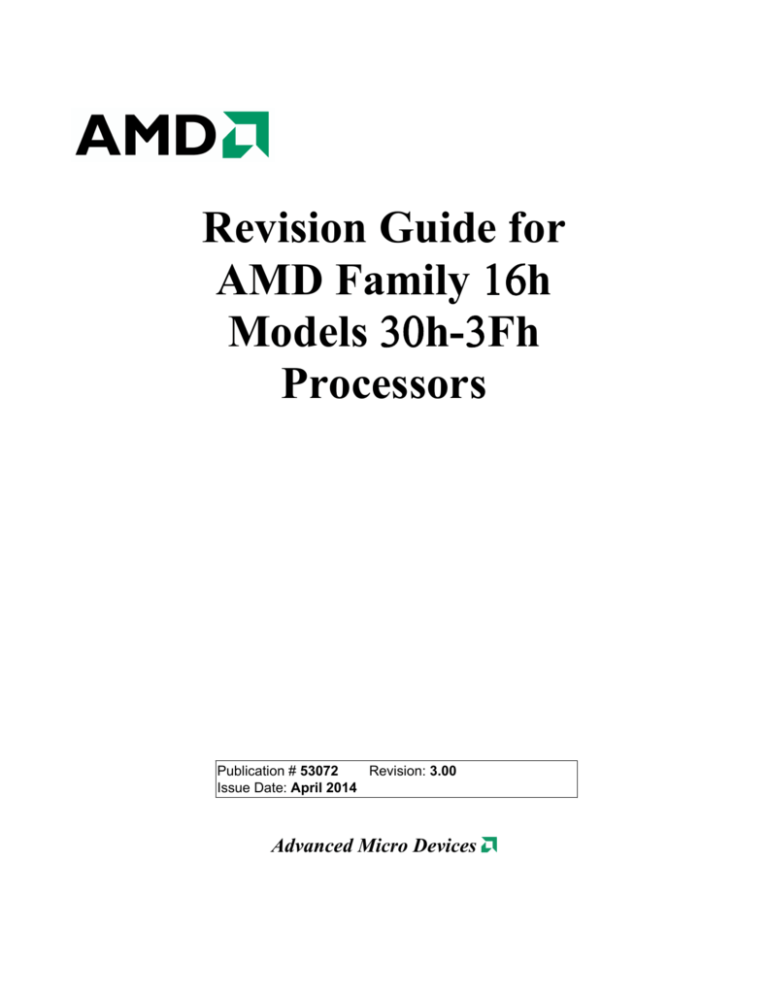
Revision Guide for
AMD Family 16h
Models 30h-3Fh
Processors
Publication # 53072
Revision: 3.00
Issue Date: April 2014
Advanced Micro Devices
©2014
Advanced Micro Devices, Inc. All rights reserved.
The information contained herein is for informational purposes only, and is subject to change without notice. While
every precaution has been taken in the preparation of this document, it may contain technical inaccuracies,
omissions and typographical errors, and AMD is under no obligation to update or otherwise correct this information.
Advanced Micro Devices, Inc. makes no representations or warranties with respect to the accuracy or completeness
of the contents of this document, and assumes no liability of any kind, including the implied warranties of
noninfringement, merchantability or fitness for particular purposes, with respect to the operation or use of AMD
hardware, software or other products described herein. No license, including implied or arising by estoppel, to any
intellectual property rights is granted by this document. Terms and limitations applicable to the purchase or use of
AMD’s products are as set forth in a signed agreement between the parties or in AMD's Standard Terms and
Conditions of Sale.
Trademarks
AMD, the AMD Arrow logo, and combinations thereof, are trademarks of Advanced Micro Devices, Inc.
PCI Express is a registered trademark of PCI-SIG.
Other product names used in this publication are for identification purposes only and may be trademarks of their
respective companies.
53072 Rev. 3.00 April 2014
Revision Guide for AMD Family 16h Models 30h-3Fh Processors
List of Figures
Figure 1. Format of CPUID Fn0000_0001_EAX......................................................................................................................9
List of Figures
3
Revision Guide for AMD Family 16h Models 30h-3Fh Processors
53072 Rev. 3.00 April 2014
List of Tables
Table 1. Arithmetic and Logic Operators.................................................................................................................................. 8
Table 2. CPUID Values for AMD Family 16h Models 30h-3Fh FT3b Processor Revisions................................................... 9
Table 3. AMD Family 16h Graphic Device IDs........................................................................................................................9
Table 4. Cross Reference of Product Revision to OSVW ID.................................................................................................. 11
Table 5. Cross-Reference of Processor Revision to Errata......................................................................................................12
Table 6. Cross-Reference of Errata to Package Type.............................................................................................................. 13
Table 7. Cross-Reference of Errata to Processor Segments.................................................................................................... 14
4
List of Tables
Revision Guide for AMD Family 16h Models 30h-3Fh Processors
53072 Rev. 3.00 April 2014
Revision History
Date
April 2014
Revision
3.00
Description
Initial public release.
Revision History
5
Revision Guide for AMD Family 16h Models 30h-3Fh Processors
53072 Rev. 3.00 April 2014
Overview
The purpose of the Revision Guide for AMD Family 16h Models 30h-3Fh Processors is to communicate updated
product information to designers of computer systems and software developers. This revision guide includes
information on the following products:
• AMD Low-Power A-Series APUs with Radeon™ Graphics
• AMD Low-Power E-Series APUs with Radeon™ Graphics
This guide consists of these major sections:
• Processor Identification shows how to determine the processor revision and workaround requirements, and to
construct, program, and display the processor name string.
• Product Errata provides a detailed description of product errata, including potential effects on system
operation and suggested workarounds. An erratum is defined as a deviation from the product's specification,
and as such may cause the behavior of the processor to deviate from the published specifications.
• Documentation Support provides a listing of available technical support resources.
Revision Guide Policy
Occasionally, AMD identifies product errata that cause the processor to deviate from published specifications.
Descriptions of identified product errata are designed to assist system and software designers in using the
processors described in this revision guide. This revision guide may be updated periodically.
6
Overview
53072 Rev. 3.00 April 2014
Revision Guide for AMD Family 16h Models 30h-3Fh Processors
Conventions
Numbering
• Binary numbers. Binary numbers are indicated by appending a "b" at the end, e.g., 0110b.
• Decimal numbers. Unless specified otherwise, all numbers are decimal. This rule does not apply to the
register mnemonics.
• Hexadecimal numbers. Hexadecimal numbers are indicated by appending an "h" to the end, e.g., 45F8h.
• Underscores in numbers. Underscores are used to break up numbers to make them more readable. They do
not imply any operation. e.g., 0110_1100b.
• Undefined digit. An undefined digit, in any radix, is notated as a lower case "x".
Register References and Mnemonics
In order to define errata workarounds it is sometimes necessary to reference processor registers. References to
registers in this document use a mnemonic notation consistent with that defined in the BIOS and Kernel
Developer's Guide (BKDG) for AMD Family 16h Models 30h-3Fh Processors, order# 49125. Each mnemonic is
a concatenation of the register-space indicator and the offset of the register. The mnemonics for the various
register spaces are as follows:
• IOXXX: x86-defined input and output address space registers; XXX specifies the byte address of the I/O
register in hex (this may be 2 or 3 digits). This space includes the I/O-Space Configuration Address Register
(IOCF8) and the I/O-Space Configuration Data Port (IOCFC) to access configuration registers.
• DZFYxXXX: PCI-defined configuration space at bus 0; Z specifies the PCI device address in hex; XXX
specifies the byte address of the configuration register (this may be 2 or 3 digits) in hex; Y specifies the
function number. For example, D18F3x40 specifies the register at bus 0, device 18h, function 3, address 40h.
Some registers in D18F2xXXX have a _dct[1:0] mnemonic suffix, which indicates there is one instance per
DRAM controller (DCT). The DCT instance is selected by DCT Configuration Select[DctCfgSel]
(D18F1x10C[0]). Some registers in D18F2xXXX have an _mp[1:0] mnemonic suffix, which indicates there
is one instance per memory P-state. The memory P-state instance is selected by DCT Configuration
Select[MemPsSel] (D18F1x10C[3]).
• DZFYxXXX_xZZZZZ: Port access through the PCI-defined configuration space at bus 0; Z specifies the PCI
device address in hex; XXX specifies the byte address of the data port configuration register (this may be 2 or
3 digits) in hex; Y specifies the function number; ZZZZZ specifies the port address (this may be 2 to 7 digits)
in hex. For example, D18F2x9C_x1C specifies the port 1Ch register accessed using the data port register at
bus 0, device 18h, function 2, address 9Ch. Refer to the BKDG for access properties. Some registers in
D18F2xXXX_xZZZZZ have a _dct[1:0] mnemonic suffix, which indicates there is one instance per DRAM
controller (DCT). The DCT instance is selected by DCT Configuration Select[DctCfgSel] (D18F1x10C[0]).
Some registers in D18F2xXXX_xZZZZZ have an _mp[1:0] mnemonic suffix, which indicates there is one
instance per memory P-state. The memory P-state instance is selected by DCT Configuration
Select[MemPsSel] (D18F1x10C[3]).
• APICXXX: APIC memory-mapped registers; XXX is the byte address offset from the base address in hex
(this may be 2 or 3 digits). The base address for this space is specified by the APIC Base Address Register
(APIC_BAR) at MSR0000_001B.
• CPUID FnXXXX_XXXX_RRR_xYYY: processor capability information returned by the CPUID instruction
where the CPUID function is XXXX_XXXX (in hex) and the ECX input is YYY (if specified). When a
register is specified by RRR, the reference is to the data returned in that register. For example, CPUID
Fn8000_0001_EAX refers to the data in the EAX register after executing CPUID instruction function
8000_0001h.
• MSRXXXX_XXXX: model specific registers; XXXX_XXXX is the MSR number in hex. This space is
accessed through x86-defined RDMSR and WRMSR instructions.
Conventions
7
Revision Guide for AMD Family 16h Models 30h-3Fh Processors
53072 Rev. 3.00 April 2014
• PMCxXXX[Y]: performance monitor events; XXX is the hexadecimal event counter number programmed
into MSRC001_020[A,8,6,4,2,0][EventSelect] (PERF_CTL[5:0] bits 7:0). Y, when specified, signifies the
unit mask programmed into MSRC001_020[A,8,6,4,2,0][UnitMask] (PERF_CTL[5:0] bits 15:8).
• NBPMCxXXX[Y]: northbridge performance monitor events; XXX is the hexadecimal event counter number
programmed into MSRC001_024[6,4,2,0][EventSelect] (NB_PERF_CTL[3:0] bits 7:0). Y, when specified,
signifies the unit mask programmed into MSRC001_024[6,4,2,0][UnitMask] (NB_PERF_CTL[3:0] bits
15:8).
Many register references use the notation "[]" to identify a range of registers. For example, D18F2x[1,0][4C:40]
is a shorthand notation for D18F2x40, D18F2x44, D18F2x48, D18F2x4C, D18F2x140, D18F2x144,
D18F2x148, and D18F2x14C.
Arithmetic and Logical Operators
In this document, formulas follow some Verilog conventions as shown in Table 1.
Table 1. Arithmetic and Logic Operators
Operator
{}
Curly brackets are used to indicate a group of bits that are concatenated together. Each set of bits is separated by a comma.
E.g., {Addr[3:2], Xlate[3:0]} represents a 6-bit value; the two MSBs are Addr[3:2] and the four LSBs are Xlate[3:0].
|
Bitwise OR operator. E.g. (01b | 10b == 11b).
||
Logical OR operator. E.g. (01b || 10b == 1b); logical treats multibit operand as 1 if >=1 and produces a 1-bit result.
&
Bitwise AND operator. E.g. (01b & 10b == 00b).
&&
8
Definition
Logical AND operator. E.g. (01b && 10b == 1b); logical treats multibit operand as 1 if >=1 and produces a 1-bit result.
^
Bitwise exclusive-OR operator; sometimes used as "raised to the power of" as well, as indicated by the context in which it is
used. E.g. (01b ^ 10b == 11b). E.g. (2^2 == 4).
~
Bitwise NOT operator (also known as one's complement). E.g. (~10b == 01b).
!
Logical NOT operator. E.g. (!10b == 0b); logical treats multibit operand as 1 if >=1 and produces a 1-bit result.
==
Logical "is equal to" operator.
!=
Logical "is not equal to" operator.
<=
Less than or equal operator.
>=
Greater than or equal operator.
*
Arithmetic multiplication operator.
/
Arithmetic division operator.
<<
Shift left first operand by the number of bits specified by the 2nd operand. E.g. (01b << 01b == 10b).
>>
Shift right first operand by the number of bits specified by the 2nd operand. E.g. (10b >> 01b == 01b).
Conventions
Revision Guide for AMD Family 16h Models 30h-3Fh Processors
53072 Rev. 3.00 April 2014
Processor Identification
This section shows how to determine the processor revision, program and display the processor name string, and
construct the processor name string.
Revision Determination
A processor revision is identified using a unique value that is returned in the EAX register after executing the
CPUID instruction function 0000_0001h (CPUID Fn0000_0001_EAX). Figure 1 shows the format of the value
from CPUID Fn0000_0001_EAX. In some cases, two or more processor revisions may exist within a stepping of
a processor family and are identified by a unique value in D18F4x164 Fixed Errata Register (see D18F4x164
Fixed Errata Register).
Figure 1. Format of CPUID Fn0000_0001_EAX
The following tables show the identification numbers from CPUID Fn0000_0001_EAX and D18F4x164 (if
necessary) for each revision of the processor to each processor segment. "X" signifies that the revision has been
used in the processor segment. "N/A" signifies that the revision has not been used in the processor segment.
D18F4x164 Fixed Errata Register
Communicating the status of an erratum within a stepping of a processor family is necessary in certain
circumstances. D18F4x164 is used to communicate the status of such an erratum fix so that BIOS or system
software can determine the necessity of applying the workaround. Under these circumstances, the erratum
workaround references the specified bit to enable software to test for the presence of the erratum. The erratum
may be specific to some steppings of the processor, and the specified bit may or may not be set on other
unaffected revisions within the same family. Therefore, software should use the CPUID Fn00000_0001_EAX
extended model, model, and stepping as the first criteria to identify the applicability of an erratum. Once defined,
the definition of the status bit will persist within the family of processors.
Bits
Description
31:0
0000_0000h. Reserved.
Graphic Device IDs
Processors with an integrated AMD Radeon HD Graphics Processing Engine use a graphics device ID at
D1F0x00[31:16] to further identify the processor.
Processor Identification
9
Revision Guide for AMD Family 16h Models 30h-3Fh Processors
53072 Rev. 3.00 April 2014
Table 3. AMD Family 16h Graphic Device IDs
D1F0x00[31:16]
FT3b
Notes
9851h
X
Notebook/Desktop (2 quad pipes, 2 SIMD & texture units, 1 render backend)
9850h
X
Notebook/Desktop (2 quad pipes, 2 SIMD & texture units, 1 render backend)
9852h
X
Notebook/Desktop (2 quad pipes, 2 SIMD & texture units, 1 render backend)
9853h
X
Notebook/Desktop (2 quad pipes, 2 SIMD & texture units, 1 render backend)
9855h
X
Tablet (2 quad pipes, 2 SIMD & texture units, 1 render backend)
9854h
X
Tablet (2 quad pipes, 2 SIMD & texture units, 1 render backend)
9856h
X
Tablet (2 quad pipes, 2 SIMD & texture units, 1 render backend)
Programming and Displaying the Processor Name String
This section, intended for BIOS programmers, describes how to program and display the 48-character processor
name string that is returned by CPUID Fn8000_000[4:2]. The hardware or cold reset value of the processor
name string is 48 ASCII NUL characters, so the BIOS must program the processor name string before any
general purpose application or operating system software uses the extended functions that read the name string.
It is common practice for the BIOS to display the processor name string and model number whenever it displays
processor information during boot up.
Note: Motherboards that do not program the proper processor name string and model number will not pass AMD
validation and will not be posted on the AMD Recommended Motherboard Web site.
The name string must be ASCII NUL terminated and the 48-character maximum includes that NUL character.
The processor name string is programmed by MSR writes to the six MSR addresses covered by the range
MSRC001_00[35:30]h. Refer to the BKDG for the format of how the 48-character processor name string maps
to the 48 bytes contained in the six 64-bit registers of MSRC001_00[35:30].
The processor name string is read by CPUID reads to a range of CPUID functions covered by CPUID
Fn8000_000[4:2]. Refer to CPUID Fn8000_000[4:2] in the BKDG for the 48-character processor name string
mapping to the 48 bytes contained in the twelve 32-bit registers of CPUID Fn8000_000[4:2].
Constructing the Processor Name String
This section describes how to construct the processor name string. BIOS forms the name string as follows:
1. If D18F5x198_x0 is 00000000h, then use a name string of "AMD Unprogrammed Engineering Sample" and
skip the remaining steps.
2. Read {D18F5x198_x1, D18F5x198_x0} and write this value to MSRC001_0030.
3. Read {D18F5x198_x3, D18F5x198_x2} and write this value to MSRC001_0031.
4. Read {D18F5x198_x5, D18F5x198_x4} and write this value to MSRC001_0032.
5. Read {D18F5x198_x7, D18F5x198_x6} and write this value to MSRC001_0033.
6. Read {D18F5x198_x9, D18F5x198_x8} and write this value to MSRC001_0034.
7. Read {D18F5x198_xB, D18F5x198_xA} and write this value to MSRC001_0035.
10
Processor Identification
Revision Guide for AMD Family 16h Models 30h-3Fh Processors
53072 Rev. 3.00 April 2014
Operating System Visible Workarounds
This section describes how to identify operating system visible workarounds.
MSRC001_0140 OS Visible Work-around MSR0 (OSVW_ID_Length)
This register, as defined in AMD64 Architecture Programmer's Manual Volume 2: System Programming, order#
24593, is used to specify the number of valid status bits within the OS Visible Work-around status registers.
The reset default value of this register is 0000_0000_0000_0000h.
BIOS shall program the OSVW_ID_Length to 0005h prior to hand-off to the OS.
Bits
Description
63:16
Reserved.
15:0
OSVW_ID_Length: OS visible work-around ID length. Read-write.
MSRC001_0141 OS Visible Work-around MSR1 (OSVW_Status)
This register, as defined in AMD64 Architecture Programmer's Manual Volume 2: System Programming, order#
24593, provides the status of the known OS visible errata. Known errata are assigned an OSVW_ID
corresponding to the bit position within the valid status field.
Operating system software should use MSRC001_0140 to determine the valid length of the bit status field. For
all valid status bits: 1=Hardware contains the erratum, and an OS software work-around is required or may be
applied instead of a BIOS workaround. 0=Hardware has corrected the erratum, so an OS software work-around
is not necessary.
The reset default value of this register is 0000_0000_0000_0000h.
Bits
Description
63:5
OsvwStatusBits: Reserved. OS visible work-around status bits. Read-write.
3
OsvwId3: Reserved, must be zero.
2
OsvwId2: Reserved, must be zero.
1
OsvwId1: Reserved, must be zero.
0
OsvwId0: Reserved, must be zero.
BIOS shall program the state of the valid status bits as shown in Table 4 prior to hand-off to the OS.
Table 4. Cross Reference of Product Revision
to OSVW ID
CPUID
Fn0000_0001_EAX
(Mnemonic)
MSRC001_0141 Bits
00730F01 (ML-A1)
0000_0000_0000_0000h
Operating System Visible Workarounds
11
Revision Guide for AMD Family 16h Models 30h-3Fh Processors
53072 Rev. 3.00 April 2014
Product Errata
This section documents product errata for the processors. A unique tracking number for each erratum has been
assigned within this document for user convenience in tracking the errata within specific revision levels. This
table cross-references the revisions of the part to each erratum. "No fix planned" indicates that no fix is planned
for current or future revisions of the processor.
Note: There may be missing errata numbers. Errata that do not affect this product family do not appear. In
addition, errata that have been resolved from early revisions of the processor have been deleted, and errata that
have been reconsidered may have been deleted or renumbered.
Table 5. Cross-Reference of Processor Revision to Errata
CPUID Fn0000_0001_EAX
No.
Errata Description
77
Long Mode CALLF or JMPF May Fail To Signal GP When
Callgate Descriptor is Beyond GDT/LDT Limit
No fix planned
361
Breakpoint Due to an Instruction That Has an Interrupt
Shadow May Be Lost
No fix planned
541
IBS Registers May be Unpredictable After CC6 State
No fix planned
638
Processor May Violate Trp During Dynamic Mode Switch
No fix planned
732
IOMMU Event Log Ordering Violation
No fix planned
733
IOMMU PPR Log Ordering Violation
No fix planned
737
Processor Does Not Check 128-bit Canonical Address
Boundary Case on Logical Address
No fix planned
756
Machine Check Information May Show Inconsistent
Signature from an Older Corrected Error
No fix planned
757
L2 Tag Error Machine Check Status May Be Incorrect
No fix planned
779
Initial Time Stamp Counter Frequency May Be Incorrect
No fix planned
786
APIC Timer Periodic Mode is Imprecise
No fix planned
792
DRAM Scrubbing May Overwrite CC6 Core Save State
Data Resulting in Unpredictable System Behavior
No fix planned
793
Specific Combination of Writes to Write Combined
Memory Types and Locked Instructions May Cause Core
Hang
No fix planned
794
Performance Monitor PMCx076 May Be Inaccurate and
Lose Overflow Interrupts When Halted
No fix planned
795
Core Performance Monitor Counters May Appear to be
Cleared to Zero in the Least Significant 32 Bits
No fix planned
798
Time Stamp Counter (TSC) value may be incorrect upon
resume from S3 state
No fix planned
799
U-bit May Not be Set Properly by IOMMU in the ATS
Response for GVA-SPA Translations
No fix planned
800
IOMMU IO_PAGE_FAULT Events Are Not Correctly
Suppressed When DTE.SA=1 and PTE.PR=0
No fix planned
801
IOMMU IO_PAGE_FAULT Event May Be Logged
Instead of INVALID_DEVICE_REQUEST Event
No fix planned
12
00730F01h (ML-A1)
Product Errata
53072 Rev. 3.00 April 2014
Revision Guide for AMD Family 16h Models 30h-3Fh Processors
Cross-Reference of Errata to Package Type
This table cross-references the errata to each package type. "X" signifies that the erratum applies to the package
type. An empty cell signifies that the erratum does not apply. An erratum may not apply to a package type due to
a specific characteristic of the erratum, or it may be due to the affected silicon revision(s) not being used in this
package.
Table 6. CrossReference of Errata
to Package Type
Errata
FP4
FT3b
Package
77
X
X
361
X
X
541
X
X
638
X
X
732
X
X
733
X
X
737
X
X
756
X
X
757
X
X
779
X
X
786
X
X
792
X
793
X
X
794
X
X
795
X
X
798
X
X
799
X
X
800
X
X
801
X
X
Cross-Reference of Errata to Package Type
13
Revision Guide for AMD Family 16h Models 30h-3Fh Processors
53072 Rev. 3.00 April 2014
Cross-Reference of Errata to Processor Segments
This table cross-references the errata to each processor segment. "X" signifies that the erratum applies to the
processor segment. An empty cell signifies that the erratum does not apply. An erratum may not apply to a
processor segment due to a specific characteristic of the erratum, or it may be due to the affected silicon
revision(s) not being used in this processor segment.
Table 7. Cross-Reference of
Errata to Processor Segments
AMD A-Series Micro APU
AMD E-Series APU
AMD E-Series Micro APU
77
X
X
X
X
361
X
X
X
X
541
X
X
X
X
638
X
X
X
X
732
X
X
X
X
733
X
X
X
X
737
X
X
X
X
756
X
X
X
X
757
X
X
X
X
779
X
X
X
X
786
X
X
X
X
Errata
AMD A-Series APU
Processor Segment
792
X
793
X
X
X
X
794
X
X
X
X
795
X
X
X
X
798
X
X
X
X
799
X
X
X
X
800
X
X
X
X
801
X
X
X
X
14
Cross-Reference of Errata to Processor Segments
53072 Rev. 3.00 April 2014
Revision Guide for AMD Family 16h Models 30h-3Fh Processors
77 Long Mode CALLF or JMPF May Fail To Signal GP When
Callgate Descriptor is Beyond GDT/LDT Limit
Description
If the target selector of a far call or far jump (CALLF or JMPF) instruction references a 16-byte long mode
system descriptor where any of the last 8 bytes are beyond the GDT or LDT limit, the processor fails to report a
General Protection fault.
Potential Effect on System
None expected, since the operating system typically aligns the GDT/LDT limit such that all descriptors are legal.
However, in the case of erroneous operating system software, the above described GP fault will not be signaled,
resulting in unpredictable system failure.
Suggested Workaround
None required, it is anticipated that long mode operating system software will ensure the GDT and LDT limits
are set high enough to cover the larger (16-byte) long mode system descriptors.
Fix Planned
No fix planned
Product Errata
15
Revision Guide for AMD Family 16h Models 30h-3Fh Processors
53072 Rev. 3.00 April 2014
361 Breakpoint Due to an Instruction That Has an Interrupt
Shadow May Be Lost
Description
A #DB exception occurring in guest mode may be discarded under the following conditions:
• A trap-type #DB exception is generated in guest mode during execution of an instruction with an interrupt
shadow, and
• The instruction that generated the exception is immediately followed by an instruction resulting in
#VMEXIT.
Potential Effect on System
None expected under normal conditions. Debug exceptions may not be received for programs running under a
hypervisor.
Suggested Workaround
None.
Fix Planned
No fix planned
16
Product Errata
53072 Rev. 3.00 April 2014
Revision Guide for AMD Family 16h Models 30h-3Fh Processors
541 IBS Registers May be Unpredictable After CC6 State
Description
The following Instruction-Based Sampling (IBS) registers may be unpredictable after the processor core exits the
core C6 (CC6) state:
•
•
•
•
•
•
•
•
•
•
Read-only bits MSRC001_1030 IBS Fetch Control Register
MSRC001_1031 IBS Fetch Linear Address Register
MSRC001_1032 IBS Fetch Physical Address Register
MSRC001_1034 IBS Op Logical Address Register
MSRC001_1035 IBS Op Data Register
MSRC001_1036 IBS Op Data 2 Register
MSRC001_1037 IBS Op Data 3 Register
MSRC001_1038 IBS DC Linear Address Register
MSRC001_1039 IBS DC Physical Address Register
MSRC001_103B IBS Branch Target Address Register
The registers are predictable as long as IBS is not enabled at the time that the processor core enters CC6 state.
Potential Effect on System
In cases where the performance monitoring software fetches the IBS sampled data and the processor core has
entered the CC6 state since this sample, the performance monitoring software may observe unpredictable values
and may generate inaccurate results. The performance monitoring software would normally consume the
sampled IBS data before a CC6 entry occurs, resulting in no observed effect under normal conditions.
Suggested Workaround
Performance monitoring software should avoid entering ACPI sleep states (C1/HALT or C2) prior to accessing
the IBS registers.
Fix Planned
No fix planned
Product Errata
17
Revision Guide for AMD Family 16h Models 30h-3Fh Processors
53072 Rev. 3.00 April 2014
638 Processor May Violate Trp During Dynamic Mode Switch
Description
The processor may violate the precharge time (Trp) for a DIMM when sending a mode register set (MRS)
command to dynamically adjust MR0[PPD] during a precharge power down.
This erratum may occur only when fast exit/slow exit (dynamic) mode is selected as follows:
• D18F2x94_dct[1:0][15] = 1b (DRAM Configuration High[PowerDownEn])
• D18F2x84_dct[1:0][23] = 1b (DRAM MRS[PchgPDModeSel])
Potential Effect on System
Unpredictable system operation.
Suggested Workaround
If D18F2x84_dct[1:0] bit 23 (PchgPDModeSel) = 1b and D18F2x94_dct[1:0] bit 15 (PowerDownEn) = 1b, then
precharge time (D18F2x200_dct[1:0]_mp[1:0] bits 20:16, Trp) should be set one higher than the DIMM
specified value.
Fix Planned
No fix planned
18
Product Errata
53072 Rev. 3.00 April 2014
Revision Guide for AMD Family 16h Models 30h-3Fh Processors
732 IOMMU Event Log Ordering Violation
Description
The processor IOMMU does not maintain producer-consumer ordering between the IOMMU event log DMA
writes and IOMMU MMIO register read completions. The processor core may read stale or uninitialized event
logs from memory when a read response from the event log tail pointer register passes the corresponding event
log DMA write. A series or burst of event log DMA writes would normally be necessary for this ordering
violation to be observed.
Potential Effect on System
Software may process an event log before it has been completely written, possibly resulting in the operating
system or hypervisor taking improper corrective actions.
Suggested Workaround
The IOMMU driver of the hypervisor or operating system should initialize the event log buffer to all zeros and
write event log entries to zero after they are processed. If software subsequently observes an all zero event log
entry, it should re-read the buffer until a non-zero event log is returned. It is recommended that software detects
that the log buffer has not been written by checking for an EventCode (bits 63:60) that is equal to 0000b.
Fix Planned
No fix planned
Product Errata
19
Revision Guide for AMD Family 16h Models 30h-3Fh Processors
53072 Rev. 3.00 April 2014
733 IOMMU PPR Log Ordering Violation
Description
The processor IOMMU does not maintain producer-consumer ordering between the IOMMU peripheral page
service request (PPR) log DMA writes and IOMMU MMIO register read completions. The processor core may
read stale or uninitialized PPR logs from memory when a read response from the PPR log tail pointer register
passes the corresponding PPR log DMA write. A series or burst of PPR log DMA writes would normally be
necessary for this ordering violation to be observed.
This erratum only applies in systems where a device is performing Address Translation Service (ATS) requests.
Potential Effect on System
Software may process a PPR log before it has been completely written, possibly resulting in the IOMMU
software not properly processing a page service request. This may result in unpredictable IOMMU behavior.
Suggested Workaround
The IOMMU driver of the hypervisor or operating system should initialize the PPR log buffer to all zeros and
write PPR log entries to zero after they are processed. If software subsequently observes an all zero PPR log
entry, it should re-read the buffer until a non-zero PPR log is returned. It is recommended that software detects
that the log buffer has not been written by checking for a PPRCode (bits 63:60) that is equal to 0000b.
Fix Planned
No fix planned
20
Product Errata
53072 Rev. 3.00 April 2014
Revision Guide for AMD Family 16h Models 30h-3Fh Processors
737 Processor Does Not Check 128-bit Canonical Address
Boundary Case on Logical Address
Description
The processor core may not detect a #GP exception if the processor is in 64-bit mode and the logical address of a
128-bit operation (for example, a octal-word SSE instruction) is canonical on the first byte, but whose final byte
crosses over the canonical address boundary. The processor does check the linear address and signals a #GP
exception if the linear address is not canonical (for all eight bytes of the operation). Therefore, this erratum can
only occur if the segment register is non-zero and causes a wrap in the logical address space only.
In the unlikely event that software causes this wrap, the processor core will execute the 128-bit operation as if
the second part of the misaligned access starts at linear address equal to zero.
Potential Effect on System
None expected, as the normal usage of segment registers and segment limits does not expose this erratum.
Suggested Workaround
None required.
Fix Planned
No fix planned
Product Errata
21
Revision Guide for AMD Family 16h Models 30h-3Fh Processors
53072 Rev. 3.00 April 2014
756 Machine Check Information May Show Inconsistent
Signature from an Older Corrected Error
Description
The processor core may not properly overwrite machine check architecture (MCA) information from an older
corrected error in MC1_STATUS (MSR0000_0405) and MC1_ADDRESS (MSR0000_0406) when presenting a
machine check exception (#MC) for a newer uncorrected error. Although the processor does set processor
context corrupt (MC1_STATUS[PCC] bit 57) to 1b and error uncorrected status (MC1_STATUS[UC], bit 61) to
1b, it does not update the remaining bits in the registers.
Potential Effect on System
The machine check handler may be presented with status and address registers that are not consistent with the
cause of the uncorrected error. It is expected that the MCA handler will respond to a #MC when
MC1_STATUS[PCC] is set with an operating system panic or crash, regardless of the remaining bits in
MC1_STATUS.
However, the information pertaining to the actual uncorrected error may be lost. In addition, debug engineers
may note that the error signature does not align to MC1 error signatures documented in the BKDG, as the error
signature will match a possibly unrelated corrected error except for the UC and PCC bits. This effect only occurs
if a processor reports both corrected and uncorrected errors.
Suggested Workaround
None.
Fix Planned
No fix planned
22
Product Errata
53072 Rev. 3.00 April 2014
Revision Guide for AMD Family 16h Models 30h-3Fh Processors
757 L2 Tag Error Machine Check Status May Be Incorrect
Description
Under a highly specific and detailed set of internal timing conditions, the MC2 status information
(MC2_STATUS, MSR0000_0409) for a corrected or uncorrected L2 tag error may not indicate the actual
operation that was occurring at the time the error was detected. The status information may report that the
processor was performing an L2 fill operation when in reality the error was detected while processing a probe.
The MC2_STATUS fields that identify the possibility that this erratum applies (i.e., when MC2_STATUS may
improperly indicate a fill operation) are:
•
•
•
•
MC2_STATUS[Valid] (bit 63) = 1b
MC2_STATUS[UC] (bit 61) = 0b or 1b (may be a corrected error or an uncorrected error)
MC2_STATUS[ErrorCodeExt] (bits 20:16) = 0Bh or 0Fh
MC2_STATUS[RRRR] (bits 7:4) = 0001b
Potential Effect on System
None expected.
Suggested Workaround
None required.
Fix Planned
No fix planned
Product Errata
23
Revision Guide for AMD Family 16h Models 30h-3Fh Processors
53072 Rev. 3.00 April 2014
779 Initial Time Stamp Counter Frequency May Be Incorrect
Description
The processor core may increment the core time stamp counter (TSC) at a frequency that is equal to the startup
P-state frequency, instead of incrementing the TSC at the software P0 frequency. This effect occurs until the first
instance of either a P-state or a C-state change.
At the time that the first P-state or C-state change occurs, the actual value in the TSC will adjust as if it had
incremented at this P-state rate for the entire duration.
Potential Effect on System
The BIOS may calculate incorrect time stamps. For example, since the TSC is incrementing at a slower rate than
it should increment, calculations of the elapsed time in BIOS boot may appear to be incorrect.
In the unlikely event that the system is in a state where one or more cores are affected by the erratum (i.e., those
cores have not performed any P-state or C-state changes) and other cores have performed a change, the operating
system software may observe TSC synchronization failures during early boot due to the different frequencies. A
normal system initialization causes at least one P-state change on all cores before the operating system boots.
Suggested Workaround
BIOS must perform a P-state change on all cores prior to the transfer of control to the operating system.
Fix Planned
No fix planned
24
Product Errata
53072 Rev. 3.00 April 2014
Revision Guide for AMD Family 16h Models 30h-3Fh Processors
786 APIC Timer Periodic Mode is Imprecise
Description
The APIC timer may not properly initialize back to the APIC timer initial count value (APIC380) when it
transitions to zero and Timer Local Vector Table Entry[Mode] (APIC320[17]) is configured to run in periodic
mode. In this mode, when the APIC timer reaches zero, the next value in the APIC current count register
(APIC390) is set to the APIC initial count (APIC380), but the processor may incorrectly add or subtract an offset
that is between 0 and 31.
Potential Effect on System
The standard use of the APIC timer and the level of accuracy required does not make this error significant.
Suggested Workaround
None.
Fix Planned
No fix planned
Product Errata
25
Revision Guide for AMD Family 16h Models 30h-3Fh Processors
53072 Rev. 3.00 April 2014
792 DRAM Scrubbing May Overwrite CC6 Core Save State
Data Resulting in Unpredictable System Behavior
Description
The processor does not properly ensure that a DRAM scrub read and write sequence is atomic with respect to
simultaneous processor core accesses to the CC6 save area. If a DRAM scrub access is to the same address as a
concurrent save of the processor state, the CC6 entry may appear as if it was not written.
Potential Effect on System
Unpredictable system behavior.
Suggested Workaround
BIOS should set Scrub Rate Control D18F3x58[4:0] = 00h to disable sequential DRAM scrubbing. BIOS should
set DRAM Scrub Address Low D18F3x5C[0] = 0b to disable re-direct DRAM scrubbing.
Fix Planned
No fix planned
26
Product Errata
53072 Rev. 3.00 April 2014
Revision Guide for AMD Family 16h Models 30h-3Fh Processors
793 Specific Combination of Writes to Write Combined Memory
Types and Locked Instructions May Cause Core Hang
Description
Under a highly specific and detailed set of internal timing conditions, a locked instruction may trigger a timing
sequence whereby the write to a write combined memory type is not flushed, causing the locked instruction to
stall indefinitely.
Potential Effect on System
Processor core hang.
Suggested Workaround
BIOS should set MSRC001_1020[15] = 1b.
Fix Planned
No fix planned
Product Errata
27
Revision Guide for AMD Family 16h Models 30h-3Fh Processors
53072 Rev. 3.00 April 2014
794 Performance Monitor PMCx076 May Be Inaccurate and
Lose Overflow Interrupts When Halted
Description
PMCx076, CPU Clocks Not Halted, should not increment whenever the core is in a halted state - e.g. due to a
stop clock, I/O C-state or HALT instruction. However, the processor may continue to incorrectly increment this
performance counter in these states. This may result in the performance monitor counter being incorrect. In
addition, since overflows are not signaled in these states, an overflow interrupt may be lost.
Potential Effect on System
Inaccuracies in performance monitoring software may be experienced.
Suggested Workaround
<KB or ML>Contact your AMD representative for information on a BIOS update. </KB or
ML><ON>None.</ON>
Fix Planned
No fix planned
28
Product Errata
53072 Rev. 3.00 April 2014
Revision Guide for AMD Family 16h Models 30h-3Fh Processors
795 Core Performance Monitor Counters May Appear to be
Cleared to Zero in the Least Significant 32 Bits
Description
Core performance monitor counters may appear to clear to zero the least significant 32 bits of the count if
disabled at the cycle that a carry-out from the least significant 32 bits to the most significant 16 bits of the
counter occurs.
Conditions which cause the counter to be disabled and may cause this erratum to be observed when:
Explicitly disabled by software through PERF_CTL[22]The PMC is designated to count only in user or OS
mode (PERF_CTL[17] is not equal to PERF_CTL[16]) and a change in the current privilege level (CPL)
occursThe PMC is designated to count only in guest or host mode (PERF_CTL[41] is not equal to
PERF_CTL[40]) and a change between guest and host mode occurs
Potential Effect on System
Inaccuracies in performance monitoring software may be experienced.
Suggested Workaround
None.
Fix Planned
No fix planned
Product Errata
29
Revision Guide for AMD Family 16h Models 30h-3Fh Processors
53072 Rev. 3.00 April 2014
798 Time Stamp Counter (TSC) value may be incorrect upon
resume from S3 state
Description
Upon resume from S3 state, the TSC value may not monotonically increment.
Potential Effect on System
Software may observe that the Time Stamp Counter (TSC) appears to decrement which could result in a program
crash.
Suggested Workaround
Contact your AMD representative for information on a BIOS update.
Fix Planned
No fix planned
30
Product Errata
53072 Rev. 3.00 April 2014
Revision Guide for AMD Family 16h Models 30h-3Fh Processors
799 U-bit May Not be Set Properly by IOMMU in the ATS
Response for GVA-SPA Translations
Description
The IOMMU incorrectly propagates the U-bit from a page table entry to an ATS response when translating guest
virtual addresses to system physical addresses instead of forcing it to 0b as described in the IOMMU
specification.
Potential Effect on System
If the U-bit is propagated as 1b, devices would not be able to use pre-translated requests after receiving the
address translation service response. This issues was observed in simulations and, to date, there have been no
detrimental impacts seen in systems.
Suggested Workaround
IOMMU driver software should ensure that the U-bit in the PTE is always set to 0b.
Fix Planned
No fix planned
Product Errata
31
Revision Guide for AMD Family 16h Models 30h-3Fh Processors
53072 Rev. 3.00 April 2014
800 IOMMU IO_PAGE_FAULT Events Are Not Correctly
Suppressed When DTE.SA=1 and PTE.PR=0
Description
IO_PAGE_FAULT events may incorrectly be logged when DTE.SA=1 and PTE.PR=0.
Potential Effect on System
This behavior has been observed in simulation. To date, no detrimental effects from this behavior have been
observed in system.
Suggested Workaround
IOMMU driver software may need to ignore extraneous IO_PAGE_FAULT event logs.
Fix Planned
No fix planned
32
Product Errata
53072 Rev. 3.00 April 2014
Revision Guide for AMD Family 16h Models 30h-3Fh Processors
801 IOMMU IO_PAGE_FAULT Event May Be Logged Instead
of INVALID_DEVICE_REQUEST Event
Description
An IO_PAGE_FAULT event may be logged instead of an INVALID_DEVICE_REQUEST event for
untranslated guest requests to the IOMMU with AT=0 and PASID TLP prefix.
Potential Effect on System
This behavior has been observed in simulation. To date, no detrimental system impact has been observed.
Suggested Workaround
IOMMU driver software may need to treat IO_PAGE_FAULT events as INVALID_DEVICE_REQUEST
events.
Fix Planned
No fix planned
Product Errata
33
Revision Guide for AMD Family 16h Models 30h-3Fh Processors
53072 Rev. 3.00 April 2014
Documentation Support
The following documents provide additional information regarding the operation of the processor:
• BIOS and Kernel Developer's Guide (BKDG) for AMD Family 16h Models 30h-3Fh Processors, order#
49125,
• AMD64 Architecture Programmer's Manual Volume 1: Application Programming, order# 24592
• AMD64 Architecture Programmer's Manual Volume 2: System Programming, order# 24593
• AMD64 Architecture Programmer's Manual Volume 3: General-Purpose and System Instructions, order#
24594
• AMD64 Architecture Programmer's Manual Volume 4: 128-Bit and 256-Bit Media Instructions, order#
26568
• AMD64 Architecture Programmer's Manual Volume 5: 64-Bit Media and x87 Floating-Point Instructions,
order# 26569
• FT3b Processor Motherboard Design Guide, order#53087
See the AMD Web site at www.amd.com for the latest updates to documents.
34
Documentation Support

